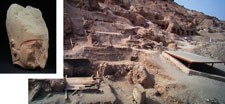Play all audios:
Access through your institution Buy or subscribe Cairo The pyramid, made of mud bricks, has collapsed, but decorations and pottery fragments in the underlying chamber will help
archaeologists shed light on Egypt in the sixteenth century bc. The period preceeded the golden age of the Pharoahs epitomized by Tutankhamen of the eighteenth dynasty and by the Ramesses
kings of the nineteenth and twentieth dynasties. “It is very important that the pyramid has turned up,” says John Taylor of the British Museum's Department of Ancient Egypt and Sudan.
“It will help us to clarify the chronology of the royals and understand how they were related.” This is a preview of subscription content, access via your institution ACCESS OPTIONS Access
through your institution Subscribe to this journal Receive 51 print issues and online access $199.00 per year only $3.90 per issue Learn more Buy this article * Purchase on SpringerLink *
Instant access to full article PDF Buy now Prices may be subject to local taxes which are calculated during checkout ADDITIONAL ACCESS OPTIONS: * Log in * Learn about institutional
subscriptions * Read our FAQs * Contact customer support Authors * Alison Abbott View author publications You can also search for this author inPubMed Google Scholar RIGHTS AND PERMISSIONS
Reprints and permissions ABOUT THIS ARTICLE CITE THIS ARTICLE Abbott, A. Pyramid find reopens lost chapter of history. _Nature_ 419, 239 (2002). https://doi.org/10.1038/419239a Download
citation * Issue Date: 19 September 2002 * DOI: https://doi.org/10.1038/419239a SHARE THIS ARTICLE Anyone you share the following link with will be able to read this content: Get shareable
link Sorry, a shareable link is not currently available for this article. Copy to clipboard Provided by the Springer Nature SharedIt content-sharing initiative

